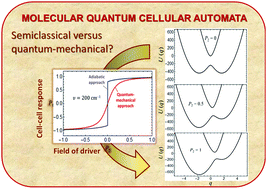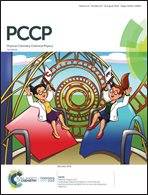Semiclassical versus quantum-mechanical vibronic approach in the analysis of the functional characteristics of molecular quantum cellular automata†
Abstract
In the context of the decisive role that vibronic interactions play in the functioning of molecular quantum cellular automata, in this article we give a comparative analysis of the two alternative vibronic approaches to the evaluation of the key functional characteristics of molecular cells. Semiclassical Born–Oppenheimer approximation and quantum mechanical evaluations of the vibronic energy pattern, electronic density distributions and cell–cell response function are performed for two-electron square-planar mixed valence molecular cells subjected to the action of a molecular driver. Special emphasis is put on the description of the cell–cell response function, which describes strong non-linearity as a prerequisite for the effective action of quantum cellular automata. Comparison of results obtained within the semiclassical and quantum-mechanical approaches has revealed a drastic difference between the shapes of the cell–cell response functions evaluated within these two approaches in the case of moderate vibronic coupling when the energy levels of the square cell interacting with a weakly polarized driver undergo large tunneling splitting in shallow adiabatic potential minima. In contrast, in the limits of strong vibronic coupling (a double-well adiabatic potential with deep minima) and weak vibronic coupling (a single well adiabatic potential) the adiabatic approximation is shown to describe the cell–cell response function with rather good accuracy.



 Please wait while we load your content...
Please wait while we load your content...